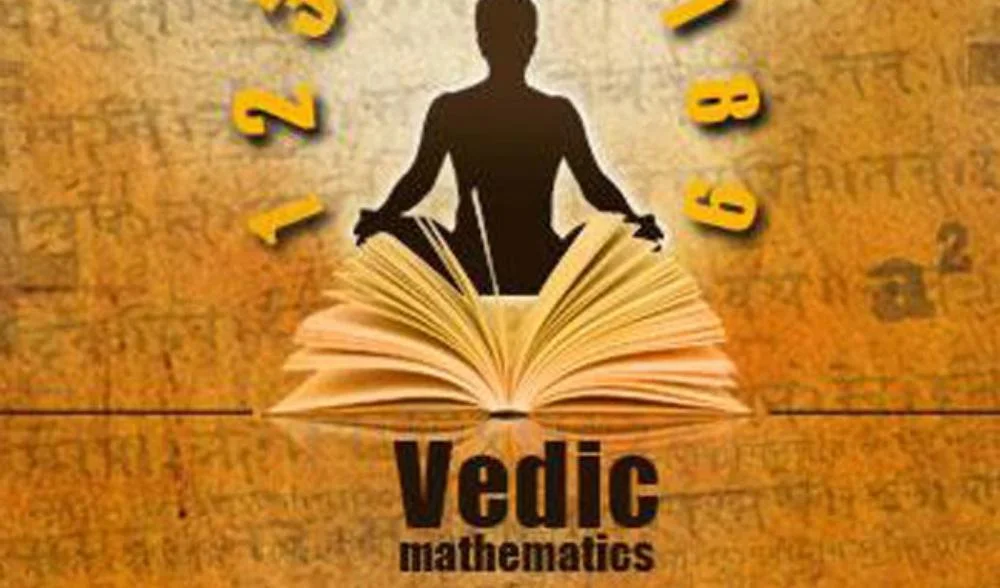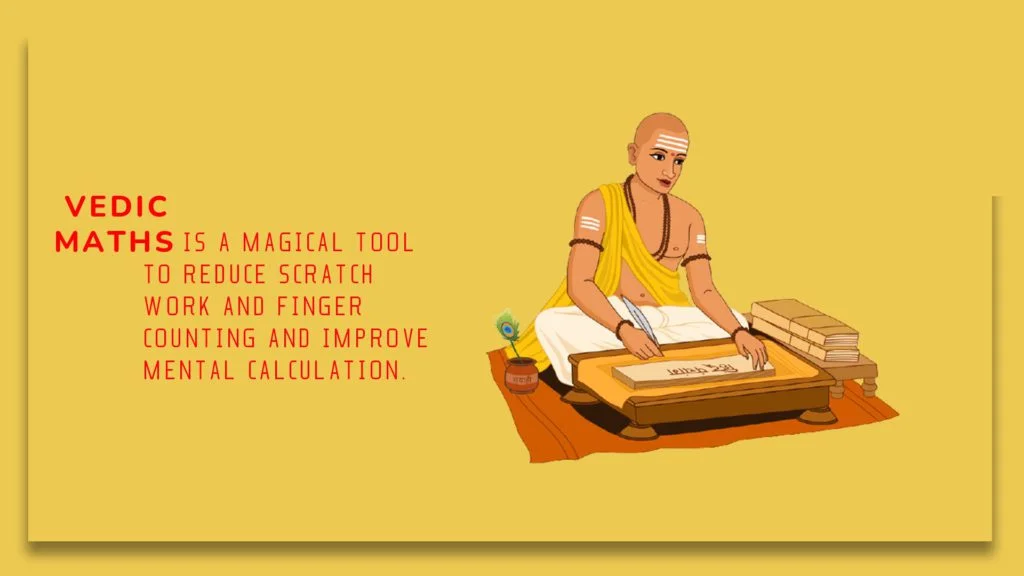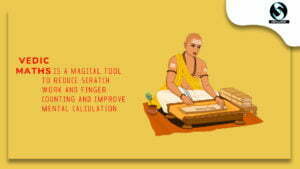Vedic Maths is a blessing to the planet from India’s historical intellectuals. Vedic Maths gets its origin from the Sanskrit term ‘Veda,’ which implies ‘Knowledge’. Several pupils may very well solve ‘Tricky’ questions or complex calculations instantly using Vedic techniques. We should learn Vedic maths to make maths more fun and engaging. It also helps in solving certain types of questions quickly and effectively.
Due to the ease of Vedic Mathematics, people can easily do computations and calculations mentally. It also comes in handy as students advance through the grades. Vedic Maths always offers a quicker method of solving quadratic and other polynomial functions and problems that pupils will come across later.

Do you want to answer complex equations ten times faster?
Vedic Maths is a compendium of strategies/sutras for quickly and efficiently solving numerical question sets. Such techniques show how to use numeric calculation, number theory, mathematical and algebraic functions, higher-level mathematics, calculus, and coordinate geometry, among other things.
It is vital to teaching students specific Vedic mathematics techniques and ideas at a young age to establish a solid framework for the kid. It is among the most sophisticated and effective mathematical methods ever devised.
People believe that Several Sanskrit scriptures have inspired the methods. Shri Bharati Krishna Tirthaji, an Indian mathematician, compiled the Sutras on Vedic Mathematics in the early twentieth century.
Vedic Maths: Then vs. Now
In the traditional numerical system, Vedic intellectuals tended not to employ figures for large values. Instead, people chose to utilize the Sanskrit alphabets, each of which corresponded to a figure. Many mantras represent numbers, like the well-known Gayatri Mantra, which, when deciphered, sums up to 108.
It is crucial to know how quickly students can answer a question. In all the exams and competitions, there is indeed a sprint against time. Only individuals with quick calculating skills would be capable of winning the competition. Students will save more time which will help them in solving more issues or tackling more challenging ones.
Vedic Mental or one- or two-line methods can be used efficaciously for tackling divisions, reciprocals, factorization, HCF, squares, and square roots, cubes and cube roots, algebraic equations, multiple simultaneous equations, among other such mathematical and algebraic operations and functions.
Important Vedic Terms
(a) Ekadhika indicates ‘one more’
- Ekadhika of 0 is 1 Ekadhika of 1 is 2
- Ekadhika of 8 is 9 Ekadhika of 23 is 24
(b) Ekanyuna implies ‘one less’
- Ekanyuna of 1 is 0
- Ekanyuna of 2 is 1
(c) Purak means ‘complement’
- Purak of 1 from 10 is 9
- Purak of 3 from 10 is 7
(d) Rekhank signifies ‘a digit with a bar on its top’. In other words, it is indeed a negative number.
(e) Beejank: The Sum of all the digits within a number is called Beejank. If the addition is a two-digit number, then these two digits can also be added up to get a single digit.
- Beejank of 27 is 2 + 7 = 9.
- Beejank of 348 is 3 + 4 + 8 = 15, further 1 + 5 = 6. i.e., 6 is Beejank.
(f) Vinculum: Vinculum numbers are those that have both positive and negative digits in their presentation.
Sixteen Vedic Sutras
- Ekadhikena Purvena – One more than the previous one
- Nikhilam Navatascaramam Dasatah – All from 9 and last from 10
- Urdhva-tiryagbhyam – Criss-cross (Vertically and crosswise)
- Paravartya Yojayet – Transpose and adjust
- Sunyam Samyasamuccaye – When the samuchchaya is the same, the samuchchaya must be equated to zero.
- (Anurupye) Sunyamanyat – If one is in ratio, then the other one is zero.
- Sankalana-vyavakalanabhyam – addition and by subtraction
- Puranapuranabhyam – completion or non-completion
- Calana-Kalanabhyam – Calculus
- Yavadunam – By the deficiency
- Vyastisamastih – Specific and General (Use the average)
- Sesanyankena Caramena – The remainders by the last digit
- Sopantyadvayamantyam – The ultimate & twice the penultimate
- Ekanyunena Purvena – By one less than the previous one
- Gunitasamuccdyah – The product of the sum of coefficients in the factors
- Gunakasamuccayah – Set of Multipliers
Quick Guide to Vedic Maths
Squaring a number that ends in 5
People will discover how to square a two-digit number finishing with 5 fast in this Vedic Maths technique. Multiply the first digit on the left with itself + 1 and put 25 at the end. That concludes our discussion.
Consider the following scenario: Find the answer to (45)2=?
- 65 × 65 =………..25 (in the end)
- 6 x (6+1) = 6 x 7 = 42
- As a result, 4225 will be the answer.
Taking any number and multiplying it by five
Usually, pupils can quickly learn the 5 times tables, but more significant numbers are more difficult to remember. However, do not be concerned! The said trick is quite easy.
Divide any integer by two to get the answer (in other words, half the number). Add a 0 to the end of the answer if it is entire. If it is not, remove the remainder and replace it with a 5. It is always practical:
Consider the following scenario: What does 2462 x 5 equal?
- 2464/2 = 1232
- Add 0 to the whole number.
- 2464 x 5 = 12320 is the solution.
Multiplying A Big Number By 5
This technique will rapidly give you the result of dividing a considerable number by 5. All guys have to execute two simple steps: multiply the number by two and then relocate the decimal point.
For instance, what is 345 divided by 5?
- Multiply 345 by 2 to get 690.
- Change the decimal to 69.0 or 69.
Number multiplication when one of the numbers is wholly made up of nines
When one of the numbers has all 9s, the technique is used. When both the multiplier (number with 9s) and the multiplicand have the same amount of digits
- Step 1: The multiplicand is one less than that of the initial component of the solution.
- Step 2: The multiplicand’s complement is the second half of the solution.
Let us look at an example: Multiply 23 × 99
- 23 – 1 = 22
- 100 – 23 = 77
- 23 x 99 = 2277 is the answer.
Find Square Roots of numbers easily
Remember the following facts while doing square roots: –
- The Square of a number cannot end with 2, 3, 7, and 8.
- We can say that numbers ending with 2, 3, 7, and 8 cannot have a perfect square root.
- A number that ends in 1 (1, 81) has a square root that finishes in either 1 or 9.
- Any number ending with 4 (4, 64) has a square root that finishes in either 2 or 8.
- If you guys find a number which ends with 9 (9, 49) has a square root that finishes in either 3 or 7.
- A number that ends in 6 (16, 36) has a square root that finishes in either 4 or 6.
- The square root of an integer with ‘n’ digits is ‘n/2’ OR ‘(n+1)/2‘ digits.
How to get the square root of 1764.
- The number ends with 4. As it is a perfect square, the square root will end with either 2 or 8.
- Find 2 perfect squares (In Multiples of 10) between which 1764 lies.
- The numbers are 1600 (40) and 2500 (50).
- Find to whom 1764 is nearer. It is nearer to 40. Therefore, the square root is nearer to 40.
- Now the possibilities are 42 or 48, out of which 42 is closer to 40.
- As a result, the square root is 42.
The guide mentioned above, coupled with the tips and tricks, will get students started with some of the basics related to Vedic Maths!
Share with your friends





